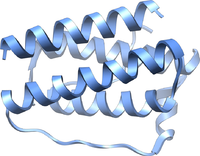
Photo from wikipedia
BACKGROUND Adipose tissue plays a pivotal role in pathology of metabolic disorders. In the past decade brown and brown-like adipose tissue were detected in adult human and show therapeutic potential… Click to show full abstract
BACKGROUND Adipose tissue plays a pivotal role in pathology of metabolic disorders. In the past decade brown and brown-like adipose tissue were detected in adult human and show therapeutic potential in aging-related metabolic diseases. OBJECTIVE This study investigated expressions of major brown adipose markers in white adipose tissue of different ages. Their associations with metabolic parameters and key adipokines were interrogated. DESIGN Cross-sectional study, 2019-2021. METHODS We recruited 21 young, 67 middle-aged and 34 older patients. Omental adipose tissues were collected and expressions of key brown markers and adipokines, and adipocyte size were evaluated. The fat depot distribution was evaluated by computed tomography. RESULTS UCP1 and PRDM16 mRNA expression declined with aging in WAT and were more associated with age, than with BMI. Increased VAT (visceral adipose tissue) amount, as well as VAT to subcutaneous adipose tissue (SAT) ratio, was decreased in the highest tertile of UCP1 expression, while individuals in different PRDM16 mRNA tertiles exhibited similar fat distribution. UCP1 mRNA was positively correlated with ADIPOQ and the strength of the correlation declined with aging. In contrast, the association between UCP1 and LEP was insignificant in young and middle-aged groups, but became significantly correlated in the older people group. We also found a positive correlation between UCP1 and PRDM16. CONCLUSIONS PRDM16 and UCP1, despite their key functions in adipose browning, exhibit differential clinical correlations with metabolic features in human WAT in an age-dependent manner. These two genes may participate in the pathogenesis of aging-related metabolic diseases, but with distinct mechanisms.
Journal Title: European journal of endocrinology
Year Published: 2023
Link to full text (if available)
Share on Social Media: Sign Up to like & get
recommendations!